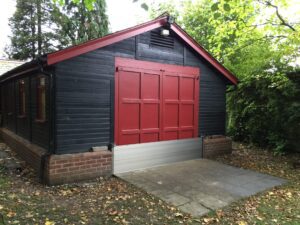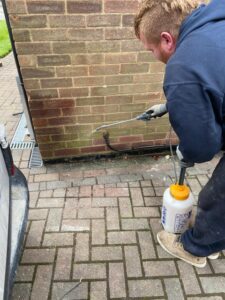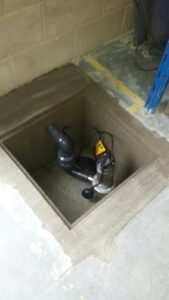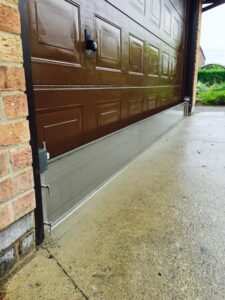6 Ways to Stop a Garage from Flooding

Flooding can be a nightmare for you and your property. Here in the UK, heavy rainfall and rising groundwater levels pose an ever-growing threat to home-owners. One of the most vulnerable areas that often gets overlooked is the garage. Even the most minor of floods can lead to thousands of pounds worth of damage if you don’t have adequate flood protection.
At Lakeside Flood Solutions, we know that proactive protection is the key to safeguarding both your property and your valuables. With over 35 years of experience in flood defence solutions, we are expert manufacturers and suppliers of robust flood barriers designed specifically for use in garages.
In this article, we’ll walk you through six of the most effective ways to prevent your garage from flooding. This includes our cutting-edge flood barrier systems, as well as other other helpful solutions that can ensure your garage is protected in the event of a flood.
How To Stop a Garage from Flooding:
1. Install a Garage Flood Barrier
For total security and peace of mind when it comes to flooding: garage flood barriers act as the ultimate line of defence.
At Lakeside Flood Solutions, we manufacture and supply industry-leading demountable flood barriers designed specifically for garages.
Our garage flood barriers are robust, watertight flood defence systems that prevent water ingress and leaking via interlocking aluminium panels. Easy to remove and to store away, these removable flood barriers are the ideal solution for flood-proofing your garage, giving you total peace of mind in the event of a flood.
These modular systems are engineered to form a secure, watertight seal that keeps rising floodwater and debris at bay, preventing seepage through your garage doors.
Explore Our Garage Door Flood Barriers
Get a Free Flood Barrier Quote Today
Key Features of Our Garage Flood Barriers:
-
Fully demountable and modular – Easy to store and set up.
-
No size limitations – Custom-fit for any garage door.

Unique interlocking system – Guarantees a watertight seal.
-
Durable construction – Made from high-quality aluminium or steel.
-
Tool-free deployment – Set up quickly in emergency conditions.
-
Compact storage – Ideal for seasonal or permanent protection.
How Flood Barriers Work:
Our flood barriers feature lightweight yet robust panels that slide into a custom-installed ground U channel. These panels interlock tightly, forming a continuous, impermeable defence. For wider openings, optional centre and corner posts offer extra reinforcement.
When flood warnings strike, this barrier can be installed in minutes—no tools, no stress. Once waters recede, the system disassembles easily and can be stored compactly until needed again.
If you’re looking for maximum protection with minimal hassle, our garage flood barrier systems are the ideal solution.
Explore Our Garage Door Flood Barriers
Reach Out Today: Give Lakeside a Call
2. Maintain & Replace Garage Door Weatherstripping
Though often overlooked, garage door weatherstripping is another crucial line of defence against wind-driven rain, standing water, and cold air seeping into your garage.
When properly installed and maintained, weatherstripping can prevent water intrusion, reduce drafts, improve energy efficiency, and even deter pests. But like any material exposed to the elements, it deteriorates over time. Keeping it in good nick is a simple, cost-effective way to ensure your garage stays protected.
What Is Garage Door Weatherstripping?
Weatherstripping is a flexible rubber or vinyl seal that lines the bottom, sides, and sometimes the top of your garage door. It compresses when the door closes, forming a seal between the door and the ground or frame. Over time, sun exposure, temperature fluctuations, dirt, moisture and other factors can degrade these materials, causing them to crack or detach themselves.
Why Weatherstripping Matters
Even a small gap can allow rainwater or cold air into your garage. Over time, weatherstripping wears out due to exposure to the above environmental factors, so it’s crucial to maintain and replace these if you wish to keep your garage dry.
Weatherstripping Maintenance Tips
-
Clean every few months with a cloth and mild cleaner to remove dirt that causes wear.
-
Inspect for cracks, brittleness, or detachment—especially along the bottom seal.
-
Lubricate with a silicone-based spray every 2–3 months to keep it flexible (avoid petroleum-based lubricants).
-
Test the seal by checking for visible light or air drafts along the edges.
When to Replace Weatherstripping
If the seal is cracked, flattened, detached, or water is entering the garage, this is the time to replace it. Replacements are affordable, and it helps to stop minor leaks before they escalate into more serious breaches that could compromise your garage interior.
Pair With a Flood Barrier
For full protection, pair fresh weatherstripping with one of Lakeside’s garage flood barriers. The weatherstripping handles small gaps; the barrier stops rising water—giving you layered, reliable defence against flooding.
Get a Free Flood Barrier Quote at Lakeside Today
3. Seal Cracks in Foundation and Garage Walls
Water doesn’t always pour in—more often than not it seeps in gradually. Cracks in your garage’s concrete floor or foundation walls can become hidden channels for water intrusion, particularly during storms or snowmelt. To combat this threat, ealing crack in your garage wall and floor foundations is vital for effective flood-proofing efforts.
Effective Crack Sealing Methods:
-
Polyurethane Foam Injection: Ideal for small cracks. It expands to fill voids and remains flexible.
-
Epoxy Injection: Best for structural cracks, as it bonds concrete while sealing against water.
-
Surface Crack Filling: Suitable for cosmetic and shallow cracks on floors or walls.
-
Flexi Span System: Combines foam strips and flexible sealant to divert water away effectively.
Once cracks are sealed, apply a waterproofing membrane or sealant, such as Liquid Rubber Foundation Sealant or a penetrating sealer, to further prevent water penetration through porous concrete.
Step-by-Step Instructions:
-
Clean and prepare cracks.
-
Inject or fill the crack using an appropriate method.
-
Seal the surface with flexible caulk or sealant.
-
Apply a waterproof coating for added protection.
-
Monitor for future movement using crack monitors if necessary.
These actions help preserve the structural integrity of your garage and prevent recurring water intrusion.
4. Apply Waterproof Sealant on Garage Walls and Floors
Even solid brick or concrete garage walls can absorb water over time—especially in prolonged wet conditions. That’s why applying a waterproof wall sealant is a crucial step in any flood-proofing strategy.
At Lakeside Flood Solutions, we supply professional-grade waterproof wall sealants designed specifically for masonry and concrete surfaces. These coatings provide a powerful, passive layer of protection that blocks water ingress while allowing the structure to breathe.

What Is a Waterproof Sealant?
A waterproof sealant is a liquid-applied membrane that soaks into the surface of your garage walls or floor. Once cured, it creates a durable, invisible barrier that repels rain, groundwater, and surface moisture—without trapping humidity inside.
Why It Works
Our sealants are 100% breathable and long-lasting, offering up to 10 years of protection. They prevent dampness, mould, and internal damage caused by moisture seepage. This is especially important in flood-prone zones where water may sit against the structure for extended periods.
Key Benefits of Our Wall Sealant:
-
100% Breathable – Prevents damp and mould by allowing moisture to escape.
-
Invisible Finish – Preserves the original appearance of brick or stone.
-
Energy Efficient – Reduces heat loss by up to 30%.
-
Long-Term Protection – Lasts up to 10 years.
-
Mould & Damp Resistant – Stops black mould before it starts.
Wall sealant is a smart, passive investment in the longevity of your garage, and combines to form an effective flood-proofing strategy alongside the other defence measures in this list.
Explore Lakeside’s Waterproof Wall Sealants
Get a Free Waterproof Wall Sealant Quote Today
5. Improve Drainage Around your Garage
Effective drainage is also essential for preventing water from collecting and seeping inside your garage. Follow the simple guide below to improve your garage’s drainage system.
Installing Channel Drainage
Channel drainage systems capture surface water before it reaches your garage door. Here’s how to install one:
-
Dig a trench around the garage entrance or along water runoff paths—approx. 18cm wide and deep.
-
Create a slope (5mm per metre) so water flows naturally toward the drain outlet.
-
Lay and connect drainage channels, sealing joints with silicone to prevent leaks.
-
Attach to a stormwater system using 110mm underground piping to divert water away.
-
Backfill with concrete, ensuring the grates sit flush or slightly lower than the surrounding surface.
Additional Drainage Tips
-
Regrade soil around the garage so water flows away, not toward the building.
-
Install catch basins or trench drains at entry points to collect heavy runoff.
-
Maintain gutters and downspouts—clear debris and ensure they direct water well away from the foundation.
By combining proper drainage with flood barriers and sealants, you create a comprehensive flood defence system that protects your garage from all angles.
6. Consider Installing a Sump Pump System
For garages vulnerable to rising groundwater or located in flood-prone areas, a sump pump is your last—and often lifesaving—line of defence.
At Lakeside Flood Solutions, we offer high-performance sump pump systems that automatically detect and remove excess water from beneath your garage floor or surrounding foundations, helping to prevent water accumulation and structural damage.

What Is a Sump Pump?
A sump pump is a submersible device installed in a sump pit, a small, below-ground basin that collects water from drains or the surrounding soil. Once the water reaches a certain level, an integrated float switch activates the pump, which then forces water out through fixed discharge pipework, away from your property.
Why It Works
Sump pumps are especially effective for managing groundwater, which can rise through concrete floors or enter through foundation cracks. When combined with proper drainage and waterproof sealants, a sump system provides active flood protection, even during prolonged or unexpected rainfall events.
Features of Our Sump Pump Systems:
-
Automatic Activation – Integrated float switch turns the pump on instantly.
-
High Capacity – Pumps up to 333 litres per minute.
-
Robust Construction – Stainless steel housing handles solids up to 35mm.
-
Suitable for Dirty Water – Ideal for real-world flood conditions.
A sump system works by collecting water in a below-ground sump pit and pumping it away through fixed pipework, preventing buildup and flooding. It’s especially effective when paired with drainage systems and wall sealants.
Explore Our Sump and Pump Systems
How To Stop a Garage From Flooding: Pro-activeness is Key
Flooding can cause irreversible damage to your garage and property. However, by combining smart design, regular maintenance, and professional-grade products like those offered by Lakeside Flood Solutions, you can effectively flood-proof your garage and avoid the financial and structural havoc that flooding can wreak.
If you’re concerned about how to protect your garage from the devastating effects of flooding, reach out to Lakeside Flood Solutions today for a cost-effective, robust solution. We can help safeguard your property, and your valuables with cost-effective, robust flood defence solutions. Reach out to our friendly team today, and we’ll be able to help you plan a robust, lasting defence strategy for your garage in the UK.
Reach Out Today; Give us a Call
